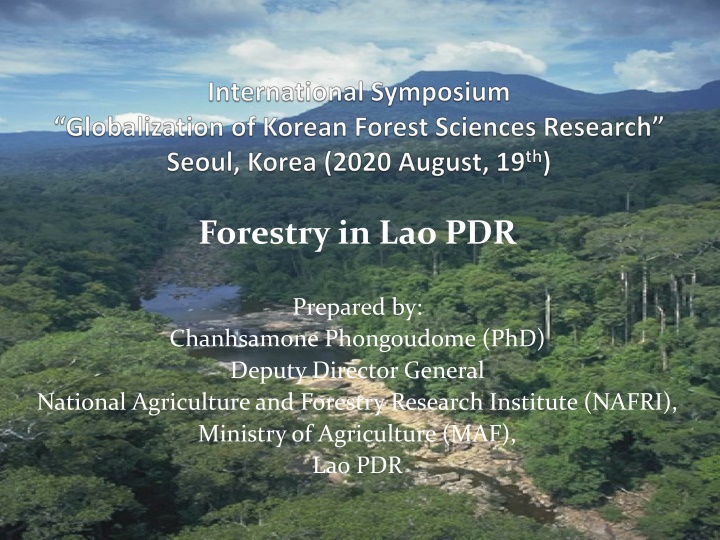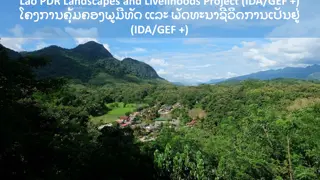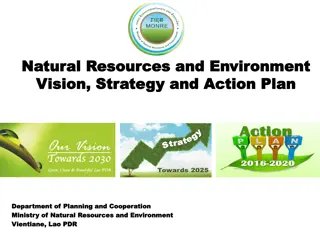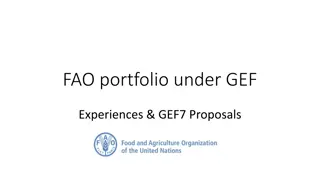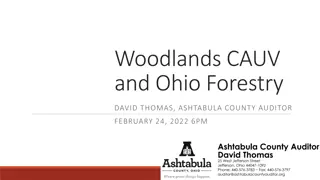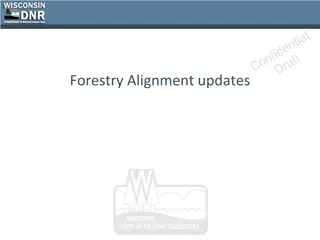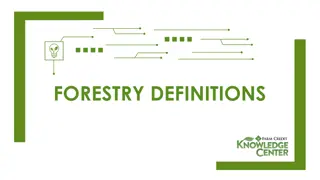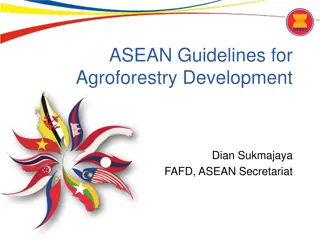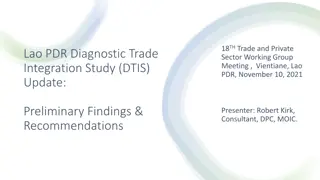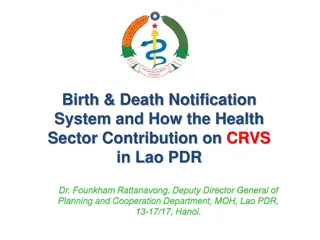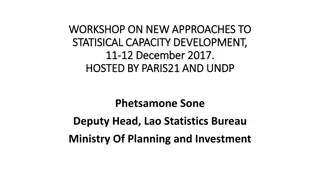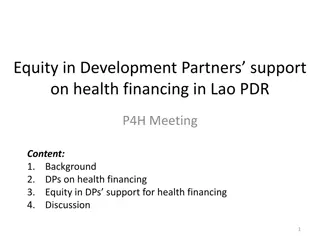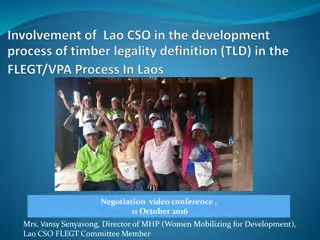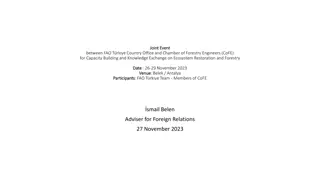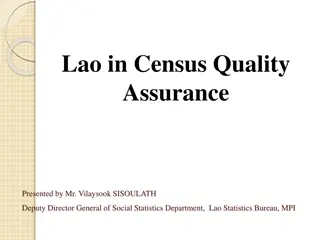Forestry Management in Lao PDR: Challenges and Opportunities
Lao PDR's forestry sector faces key challenges, with forests serving crucial roles in water resource protection, biodiversity conservation, and economic development. The country's forest management categorizes forests for protection, conservation, and production purposes. The forest cover and land use change from 1982 to 2015 reflect the dynamic landscape. Understanding these aspects is essential for sustainable forestry practices and future cooperation in the sector.
Download Presentation

Please find below an Image/Link to download the presentation.
The content on the website is provided AS IS for your information and personal use only. It may not be sold, licensed, or shared on other websites without obtaining consent from the author.If you encounter any issues during the download, it is possible that the publisher has removed the file from their server.
You are allowed to download the files provided on this website for personal or commercial use, subject to the condition that they are used lawfully. All files are the property of their respective owners.
The content on the website is provided AS IS for your information and personal use only. It may not be sold, licensed, or shared on other websites without obtaining consent from the author.
E N D
Presentation Transcript
Forestry in Lao PDR Prepared by: Chanhsamone Phongoudome (PhD) Deputy Director General National Agriculture and Forestry Research Institute (NAFRI), Ministry of Agriculture (MAF), Lao PDR
Content General information I. II. Forest institution in Lao PDR III. Keys challenges in forestry sector IV. Forest Society V. Status and future cooperation with ROK
I. General Information Country area of 23.68 million ha; Population of 7.11 million (2019); GDP per capital = US$ 2,585; where Services 41.61%; Industry 31.53%, Agriculture-Forestry 15.71%, tax 11.15% (2018); 49 ethnic groups; 76% of work force in agriculture and forestry sector; Nearly 80% live in rural areas and depend heavily on forest resource for subsistence, especially NTFPs.
Forest Management in Lao PDR Forests in Lao PDR are classified into three categories for the purpose of preservation and development as follows: - Protection Forests are forests classified for the function of protecting water resources, river banks, road sides, preventing soil erosion, protecting soil quality, strategic areas for national defense, protection from natural disasters, environmental protection and so on; - Conservation forests are forests classified for the purposes of conserving nature, preserving plant and animal species, forest ecosystems and other valuable sites of natural, historical, cultural, tourism, environmental, educational and scientific research experiments; - Production Forests are natural forests and planted forests classified for the utilization purposes of areas for production, and wood and forest product businesses to satisfy the requirements of national socio-economic development and people s living.
3 Forest Categories Map Conservation Forest 4.9 million ha Protection Forest 7.9 million ha Production Forest 3.1 million ha
Status Forest cover 1982 - 2015 Forest and Land use Change during 1982-2015 (Unit: 1,000 ha) 14,000 12,000 10,000 8,000 6,000 4,000 2,000 - 1982 1992 2002 2010 2015 Current Forest Potential Forest Other Land Use
Forest institutions (management, research, education and industrial) - Department of Forestry, MAF - Department of Forest Inspection, MAF - Forest Research Centre, NAFRI, MAF (Since 1996) - Provincial Forestry Office, MAF - Districts Forestry Unit, MAF - Village Forest, MAF - Colleges of Agriculture and Forestry (Luang Prabang, Bolikhamxay, Savanhnakhet, Champasack), MAF since 1982 - Faculty of Forest Sciences, National University of Laos (MoES), since 1996 - Faculty of Agriculture and Forest Resources, Souphanouvong University (MoES), - Faculty of Natural Resources and Environment, Savanhnakhet University (MoES), - Ministry of Industry and Commerce is responsible for dealing with the import and export of timber and wood processing. - Ministry of Planning and Investment is responsible for FDI & DDI.
Forest Research 1980-1985 Forest Restoration Unit, State Forest Enterprise No. III, (Mainly focus Nursery and Plantation) 1986-1995 Forest Silviculture Division, DoF 1996-2010 Forest Research Centre (4 Research Unit: Forest Silviculture, Agroforestry, Non-Timber Forest Products, and Tree Seed and Tree Improvement) 2011-2015 Forest Research Centre (4 + 1 Research Unit: Forest Silviculture and Community Forest, Forest Botany and Ecology, Rubber and Oil Plant, Forest and Climate Change) 2016-2020: Silviculture, Ecology, Biodiversity, climate change Remark: Forest Policy Research (Agriculture and Forest Policy Research Centre, NAFRI), Departments: DoF, DoFI, Department Forest Products and Policy FFS/NUOL.
Forest Education Ministry of Agriculture & Forestry (MAF): < 1970: no school of Forestry (abroad: French, India, Thailand, Canada) 1970-1981: School of Agriculture and Forestry (Dip.) 1982-1995: School of Forestry (Dip.) Luang Prabang, Bolikhamxay, Champasak 1982 currently: School of Agriculture and Forestry (Dip., Hdip.) Luang Prabang, Bolikhamxay, Savanhnakhet, & Champasak Ministry of Education & Sport (MoES): 1996 Faculty of Forestry, National University of Laos (Bsc) 2003 Department of Forest Resources, Faculty of Agriculture and Natural Resources, Souphanouvong University (Bsc) 2003 Faculty of Natural Resources, Champasak University (Bsc) 2006 Faculty of Forestry, National University of Laos (Bsc, Msc) 2009 Department of Forest-Environment, Faculty of Agriculture and Environment, Savanhnakhet University (Bsc) 2013 Faculty of Forestry, National University of Laos (Bsc, Msc, PhD)
Legal in forestry and related Water Resources Management Law (1996) need to revise Agriculture Law (1998) need to revise Land Law (2019) Environment Strategy to the year 2020 (2004) ongoing to revise Biodiversity Strategy to the year 2020 (2004) ongoing to revise Forest Strategy to the year 2020 (2005) ongoing to revise Forestry Law (2019) Wildlife and Aquatic Law (2007) PM Decree on Forest Production (2002, 2007, 2008) PM Decree on Forest Protection (2010) PM Decree on Forest Conservation (2015) PM Decree on Village Forest, REDD (Draft) Climate Change Strategy to the year 2020 (2010) Environmental Protection Law (2012) Industry Processing Law (2013) National Constitution (2015)
Main Policy Targets 2020 and Vision 2030 o To managed and approve the quality of existing forested areas; o Increase forest coverage from 40% in 2010 up to 70% in the year 2020; o Restoration by nature regeneration of up to 6 million ha and trees planting of up to 500,000 ha in un stocked forest areas; o To conserve the environment, including protection of soil erosion, conservation of watershed and climate; o To preserve the many plant and animal species and the prevention of natural disasters.
Overview of the forest ecotourism o Main Sites of Ecotourism Nam Ha national protected area (ASEAN Heritage) Hin Nam No national protected area (World Heritage) Nam khan national protected area Nam Eth Phou leuy national protected area Phou khao kouay national protected area Nam Ka Ding national protected area Dong Houasao national protected area
Conservation and Tourism Current forest cover is about 48% Home to a wide variety of plants and animals (60 globally threatened species of mammals, birds, amphibians, and reptiles) Natural heritage and scenic beauty one of prime destinations for nature and cultural based tourism Many natural & cultural sites attract tourists are found within & around NPAs Increasing potential for tourism development Tourism development a way to assisting poverty alleviation and sound management of NR Tourism depends on quality natural environments = human environments, resources and cultures Tourism needs to consider and address a range of different developmental and environmental issues; therefore need to combine NRM with poverty alleviation
Chi 16% Mya 2% Lao 35% Forest in Laos supported 35% of water contribution of the Mekong River Basin (Laos: 1,898 km) Vie 11% Tha 18% Cam 18% 15
Current status of ES process and Ecosystem services Opportunities in Lao PDR Current status of ES process Perception and approach for ES and BC Watershed management (hydropower) Hydropower companies are required to protect upstream catchments under: The concession agreement The project ESIA and management plans Under PM Decree 333 Article 31 (forests) Combinations of these. Current approach Responsibility for carrying out watershed management activities often shared between the government and the company 16
Companies are typically required to fund government led activities through a central government fund or by funding departments to carry out activities Responsibilities can become unclear with overlaps. An alternate approach using ES Company has clear responsibility for catchment management activities The government sets clear and measurable targets The hydropower company is responsible for achieving these targets Company funds activities directly - through a ES scheme GOL monitors compliance with targets Clear non-overlapping responsibilities. 17
Strengths and area for improvement of ES scheme and BC Watershed management REDD projects. Capacity, strategy and Action Environmental governance is not yet effectively addressed, ES is a very new concept and is not yet well understood by the majority of the people. The government has recently recognized the importance of ES in sustainable socio-economic development and poverty alleviation and has taken it as a key policy objective, the use of ES schemes is not widely practiced. It is implemented as project-specific in nature and lacks consistency in its application. 18
Ecosystem services Opportunities in Lao PDR Laos has some characteristics that support the development of a clear system for implementation of ES schemes. o First, significant legal foundations are already in place. o Second, reflected in some of this legislation is clear policy support for the userpays principle.
o Third, the GoL relies extensively on forestry and hydropower sectors for national development, yet is in a near-constant mode of giving away the country s rivers and lending watersheds to foreign investors, for the foreigners own income generation(through Build, Own, Operate, Transfer (BOOT) arrangements). This is a prime, fertile environment for the development of large-scale, user-pays ES schemes. o Finally, in Laos there is now an emerging generation of young, well- educated professionals who are committed to conservation and genuine sustainable development. As they advance to positions of responsibility in the country, the enabling environment for ES will improve.
II. Keys challenges Improving forestry education Infrastructure in Forestry Research and Developments Capacity building for foresters Public awareness
III. Forest society in Laos Journal of Agriculture and Forest Research by NAFRI (since 1999) Laos Biodiversity Association; Laos Rubber Association; Vientiane Orchid by individual foreigner; Pha Tad Ke Botanical Garden, Luang Prabang by foreigner; FDI forest plantation (Japan, China, Viet Nam, Thailand, India, ); DDI forest plantation, ecotourism, garden; Small individual plantation; Village forestry/community forestry;
IV. status and future Cooperation with ROK 2000-2020 - 2000-2015 AKECOP (research and education: 1 PhD, 3 MSc) - 2010-2020 AFoCo/KFS (landmark) - 2014-2018 KNA (biodiversity) - KGPA (1 PhD, 2 MSc) - Kangwon University and Souphanouvong University - 2021-2030 - NIFOS - KNA - KFS - .
Overview 2000 2015 in Lao PDR 1st AKECOP planning workshop UPLB Jan 2001 Lao PDR joint AKECOP as Regional Research by FRC/NAFRI (1 July 2001 30 June 2005) Agroforestry & Restoration of degraded forest and forestlands 2nd AKECOP Planning workshop Jakarta 2006 (1 July 2005-30 June 2008) focus on capacity building 1 PhD, 1 Msc, & short term training 3rd AKECOP planning workshop SNU 2008 (1 July 2008 ~ 30 June 2011) capacity building and joint research FRC-NAFRI with Indonesia FoF-IPB on Promoting Sustainable Use of Biomass Energy in Rural ASEAN 4th AKECOP planning workshop SNU 2011 (1 July 2011 ~ June 2012) DOF/FRC-NAFRI; (1 July 2012 ~ currently) DFRM/MONRE & FRC/NAFRI/MAF Biomass and Biodiversity conservation
